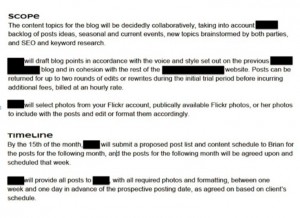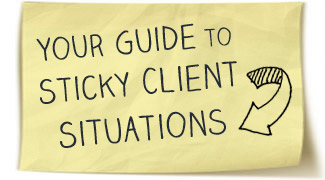
Earlier this year, a freelance writer reached out to me for help with an unfortunate situation.
She was working on an important article for a trade magazine, a magazine that isn’t available on the newsstands but is sent directly to people who work in a certain industry. In this case, it was an architecture publication.
This article was so big that she had to interview ten different architects and transcribe the story before she even began writing. But once she finished the interviews, incorporated all the information into a cohesive article, and turned it in, her client decided that she wanted the article to cover a slightly different topic.
She expected the freelancer to redo all ten interviews and rewrite the piece because she changed her mind. And she assumed it would be done without any additional pay.
The Dangers of Scope Creep
Though this is a particularly terrible case, I bet something similar has happened to almost all self-employed women at one point or another.
- You’re a web designer who agreed to create a website for a certain fee based on the initial conversation you had with a client on what they were looking for. Then, the next thing you know, they want 50 pages instead of five.
- As a PR consultant, you are handling a launch for a small business that was initially planned for three metro markets. After you’ve laid the groundwork, they think it looks so great they ask you to add two more markets to the launch.
- You gave your coaching mentee some actions to take between coaching sessions, but now they are emailing you three page emails multiple times a day between sessions asking for intensive coaching about how to carry out those actions. But your basic phone mentoring does not include unlimited email support.
No matter what form it takes, this type of behavior is called scope creep. The scope—the work involved—slowly become grander and wider than what was initially agreed.
Anytime you have a large or long project—particularly for strategists, graphic designers, ghostwriters, and website developers—scope creep is almost guaranteed to threaten you toward minimum wage.
Nearly every instance of scope creep can be traced, at the root, back to one of three reasons:
- no initial contract
- lack of specific details on work scope, process, and pay
- the freelancer goes out of her way (and scope) for the client once or twice to be nice
When You Don’t Have A Contract
Of course the client is asking for more. They don’t have to pay you until they feel like it.
It may sound terrible, but if you don’t have anything in writing regarding how much you are being paid, when, and for what, the client has absolutely no obligation to finish the project until they feel like you have done everything that they expected from their vision of the project.
If you started out without a contract, and find that the client is asking for more than you expected, it’s not too late.
Explain, clearly and politely, that what they are asking for is more than you understood from your initial discussions of the project. And because of that, you want to make sure that everything is in writing now to make sure there are no further misunderstandings.
Framing it like you are the one who has misunderstood and that you are trying to protect the client for the future makes it much more palatable.
To take extra steps to prevent further scope creep—from a client you know is already a likely culprit—add a clause to the contract outlining your fees should the project continue to creep.
When You Haven’t Been Specific Enough
Lack of clarity on the client’s part, regarding exactly what they want done, how they want it done, and when they want it done, is the origin of most scope creep.
Wikipedia defines scope creep as:
Either new products or new features of already approved product designs, without corresponding increases in resources, schedule, or budget.
Adding something new after you’ve agreed on a project is the biggest obstacle you’ll encounter. When you are working with a client on a process they don’t know yet, this is bound to happen.
If you’ve been hired to jumpstart a company’s social media strategy, they probably don’t really understand yet that posting on their blog just twice a month and tweeting a few times a week won’t get them anywhere.
The best way to stem scope creep is to make your collaboration as clear—even excruciatingly so—as possible on who does what when and precisely what you are responsible for. Here’s an example I borrowed from a blogger who ghostwrites posts for her clients:
You can stem this cause of scope creep by taking ample time when you are first outlining a collaboration to get all of the details. And, fortunately, like the no-contract issue, when this type of scope creep happens, you can go back to square one and set things straight.
Tell the client that you apologize for the misunderstanding, but you did not realize that these aspects were part of the agreement when you first began. Ask to schedule a call to discuss working methods.
Afterward, follow up with a detailed email outlining what you discussed and how things will proceed in the future.
When You Open the Door to Scope Creep By Being Nice
In a future post, I’ll talk about how to handle becoming “friends” with clients, particularly when they use it to ask you to do extra things for them.
For now, I just want to make it clear that if you’re going to draw a line, you have to draw it upfront.
If a client asks you to do a project on a rush—overnight, on the weekend, or simply in less time than you know they normally give—and you do it without charging extra or even mentioning, “I typically charge extra, but I’ll let it slide this once,” you’ve set a bad precedent.
The same goes for rescheduling coaching calls at the last minute or cancelling product orders with no penalty.
If you let something go without a heads up that this will be the only time it can happen, you’ve set expectations that that sort of behavior is acceptable in your business relationships. And it’s incredibly hard to get out of.
When this sort of behavior continues, you have to ask yourself honestly if this relationship is affecting you negatively more than it is worth. If you feel like the client is an important part of your portfolio and represents a large potential for future income, ask them to schedule a call to discuss the situation.
Let the client know that you’ve really enjoyed working with them so far and look forward to your future collaborations, but that you wanted to discuss some process details to create a smooth hand-off of information.
You can do it over email, but waiting for a response can actually be scarier! And there’s more room for misunderstanding.
Be Clear and Firm
It sounds simple, but these are the keys to avoiding scope creep in 90% of situations.
Being clear and firm is incredibly difficult when you really need more business or you’re trying land a high-profile client. But the more you practice, the more ingrained it gets in your business persona.
Want more help with more client situations?






